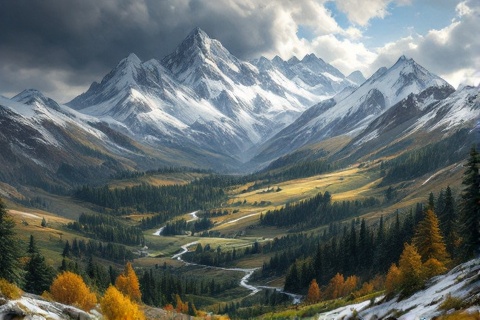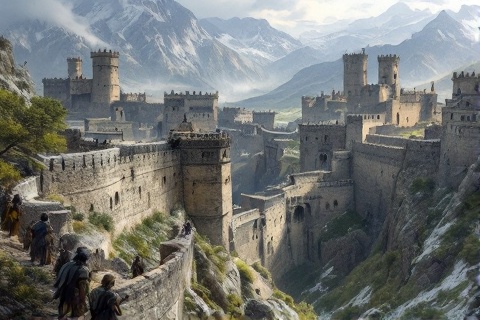
The Legacy of Dor-lómin
Exploring the Storied Land of the House of Hador in Tolkien's Middle-earth
Geographic Location and Features

Dor-lómin constituted the southern region of Hithlum, occupying a vast plateau
enclosed by the mighty Mountains of Shadow, known in Sindarin as the Ered
Wethrin. These formidable peaks formed a natural fortress wall around the
region, rising steeply on three sides and creating a defensible heartland that
would become crucial in the wars against Morgoth. The grey
stone faces of these mountains gave Hithlum its name, meaning 'Land of Mist' in
Sindarin, due to the clouds that often clung to their peaks.
The region's connection to Nevrast lay through the Pass of Annon-in-Gelydh, also
known as the Gate of the Noldor. This crucial passage was
originally hewn by Turgon's people during their journey from Hithlum to Nevrast,
creating a secret route that would later prove vital for communication and
movement between these important realms of the Noldor and their allies. The pass
represented one of the few reliable routes through the Mountains of Shadow, its
strategic importance growing as the First Age progressed.
The climate of Dor-lómin was characterized by its stern northern nature, with
cold winds sweeping down from the Ice of the North. Despite these harsh
conditions, the land was blessed with remarkably fertile soil, enriched by
ancient glacial deposits and the weathering of the surrounding mountains. This
combination of challenging weather and rich earth shaped both the agriculture
and the character of its people, fostering a hardy and resourceful population.
The strategic significance of Dor-lómin cannot be overstated, as it formed a
crucial bulwark against the forces of Angband. Its position in
the chain of defenses protecting Beleriand made it an
essential stronghold in the long war against Morgoth. The region's natural
fortifications, combined with its well-defended passes and vigilant warriors,
created a formidable barrier that helped contain the dark forces of the North
for many years during the First Age.
Climate and Natural Resources
The winters of Dor-lómin were legendary for their severity, with snow often
blanketing the landscape for months at a time. The growing season was brief but
intense, requiring careful planning and agricultural expertise from its
inhabitants. These challenging conditions fostered a culture of preparation and
resourcefulness among the people of the region, who learned to make the most of
every favorable day for cultivation.
Despite the brevity of its growing season, Dor-lómin's soil proved remarkably
fertile, supporting substantial agricultural production. The rich, dark earth,
enhanced by millennia of natural processes, yielded bountiful harvests of hardy
grains and root vegetables. This agricultural prosperity helped sustain not only
the local population but also contributed to the broader resistance against
Morgoth by feeding the armies of the Edain and their allies.
The forests of Dor-lómin were vast and ancient, providing essential resources
for its inhabitants. These woodlands offered abundant timber for construction,
fuel for the long winters, and plentiful game for hunting. The forest management
practices of the House of Hador ensured sustainable use of these resources,
maintaining the delicate balance between exploitation and conservation.
The encompassing mountain ranges created an impressive natural fortress around
Dor-lómin. The Ered Wethrin's steep cliffs and narrow passes made the region
naturally defensible, while the sheltered valleys within offered protection from
the worst of the northern winds. These geographical features played a crucial
role in the region's ability to maintain its independence and strength
throughout much of the First Age.
Architecture and Settlements

The architecture of Dor-lómin reflected its people's heritage and practical
needs, with fortified homesteads built to withstand both harsh weather and
potential attacks. These structures showed clear influence from the northern
traditions of the Edain, featuring solid timber construction, steep roofs to
shed snow, and strategic placement for defense. The buildings were often
surrounded by sturdy palisades and incorporated watch-points for early warning
against threats.
At the heart of Dor-lómin's social structure were the great halls, magnificent
structures that served as centers of governance, celebration, and community
gathering. These halls, most notably that of the House of Hador, were built with
high-timbered roofs and long hearths, providing spaces where warriors,
craftsmen, and farmers could gather during the long winter nights to share
tales, songs, and counsel. The halls embodied the people's values of community,
hospitality, and martial prowess.
The watchtowers of Dor-lómin stood as silent sentinels along the mountain
passes, crucial elements in the region's defensive network. These structures,
built from local stone and positioned at strategic vantage points, enabled early
warning of approaching threats and maintained communication lines throughout the
territory. The towers were staffed year-round by rotating guards who endured the
harsh conditions to maintain their vigilant watch.
The agricultural settlements of Dor-lómin were thoughtfully placed throughout
the fertile valleys, taking advantage of the rich soil while maintaining
defensive positions. These communities developed sophisticated farming
techniques adapted to the short growing season, including terraced fields and
careful crop rotation. The settlements were connected by well-maintained paths
that facilitated trade and communication, creating a resilient network of
communities.
Flora and Fauna
The vegetation of Dor-lómin adapted to its challenging climate, developing hardy
characteristics that enabled survival in the cold northern conditions. The
plains were covered with tough grasses and small, weather-resistant flowering
plants that could withstand the harsh winters and short growing seasons. These
adaptations created a unique ecosystem that supported both wildlife and domestic
livestock.
The region's extensive pine and evergreen forests dominated the landscape,
particularly along the foothills of the Ered Wethrin. These ancient woodlands
consisted of towering pines, firs, and other coniferous trees that remained
green throughout the year. The forests provided essential windbreaks against the
cold northern winds and served as vital sources of timber and fuel for the
inhabitants.
Dor-lómin supported a diverse array of wildlife well-adapted to its northern
climate. The forests and mountains were home to numerous species including deer,
which provided an important food source, wolves that roamed the wilderness, and
various mountain birds that filled the air with their calls. This wildlife
played a crucial role in the region's ecosystem and provided important resources
for the human inhabitants.
Cultural Significance

As the seat of the House of Hador, Dor-lómin represented one of the most
prominent realms of the Edain in the First Age. The House of Hador, beginning
with Hador Lórindol himself, established a legacy of leadership and nobility
that would influence the history of Middle-earth for
generations. Their governance brought prosperity and stability to the region,
creating a society that valued both strength and wisdom.
The warrior tradition of Dor-lómin was renowned throughout Beleriand, with its
cavalry being particularly celebrated. The horsemen of the House of Hador were
among the finest in Middle-earth, their skill developed through generations of
breeding and training horses suited to the challenging terrain and climate.
These mounted warriors proved invaluable in the great battles against Morgoth's
forces.
The people of Dor-lómin maintained rich oral traditions, preserving their
history and culture through songs and tales passed down through generations.
Their bards and storytellers were highly respected, keeping alive the memories
of great deeds and ancient wisdom. These traditions helped maintain the cultural
identity of the people even in times of hardship and upheaval.
The reputation of Dor-lómin's people for hospitality and valor was well-earned
and widely known. Their halls were open to allies and travelers, offering
shelter and sustenance in the tradition of the Edain. The courage of Dor-lómin's
warriors became legendary, particularly in their unwavering resistance against
the forces of Morgoth, even in the face of overwhelming odds.
Strategic Importance

Dor-lómin's strategic position made it an essential defensive point in the war
against Angband. The region's location and natural fortifications allowed it to
serve as a crucial buffer zone, helping to contain Morgoth's forces and prevent
them from overwhelming the southern regions of Beleriand. The warriors of
Dor-lómin maintained constant vigilance, their presence deterring many potential
incursions from the North.
The control of mountain passes through the Ered Wethrin gave Dor-lómin
significant strategic importance. These passages were vital for communication
and movement between different regions of Beleriand, and their defense was
crucial to maintaining the integrity of the free peoples' territories. The House
of Hador's careful management of these routes helped maintain lines of
communication and supply throughout the wars of the First Age.
Dor-lómin's central location made it an ideal point for coordination between the
various houses of the Edain and their Elven allies. The region served as a
meeting ground where different peoples could gather to form alliances and plan
joint actions against their common enemy. This role as a cultural and political
crossroads strengthened the bonds between the various peoples opposing Morgoth.
The region played a vital role in protecting western Beleriand, forming part of
a chain of defenses that helped maintain the freedom of the lands to the south
and west. The steadfast resistance of Dor-lómin's people, combined with their
strategic position and strong fortifications, contributed significantly to the
long resistance against Morgoth's dominion. Their sacrifices and valor helped
preserve hope for all the free peoples of Beleriand during the darkest days of
the First Age.
